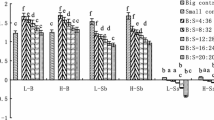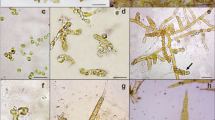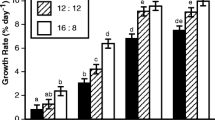Abstract
Kelps are economically valuable primary producers; therefore, many studies on breeding have attempted to increase kelp productivity and quality. However, most cultivation tests have been performed in the ocean, thereby limiting the development of new cultivars. To reduce the breeding duration period and confirm cultivar phenotypes, we developed a novel tank culture system, referred to as a circulation and floating culture system (CFCS), for cultivating macroalgae. In the CFCS, kelp can be cultivated under controlled environmental conditions. Water velocity in the CFCS can be regulated by changing the angle of a seawater inlet spout without changing the volume of seawater in the tank. Undaria pinnatifida and Saccharina japonica cultivated in the CFCS exhibited morphological features very similar to those of plants grown naturally in the ocean. The result suggests that the facility is useful for identifying water motion conditions suitable for increasing the production of any macroalgae species. Using this facility, both species were grown from juvenile sporophytes (20 mm) to maturity; for U. pinnatifida, the subsequent generation was successfully cultivated. Improved growth of U. pinnatifida was achieved in fast flows compared with slow flows, whereas S. japonica developed a wider shape and heavier biomass in slow flows compared with fast flows. We discuss the application and implication of the CFCS for breeding research and the physiological ecology of macroalgae.







Similar content being viewed by others
References
Dan A, Ohno M, Matsuoka M (2015) Changes of the research and development on the resources of Undaria and Laminaria in the culture ground of Tokushima coasts. Bull Tokushima Pref Fish Res Inst 10:25–48 (in Japanese with English abstract)
FAO (2010) The state of world fisheries and aquaculture. FAO, Rome, p. 197
Gao K, McKinley K (1993) Use of macroalgae for marine biomass production and CO2 remediation: a review. J Appl Phycol 6:45–60
Gao X, Endo H, Taniguchi K, Agatsuma Y (2013) Genetic differentiation of high-temperature tolerance in the kelp Undaria pinnatifida sporophytes from geographically separated populations along the Pacific coast of Japan. J Appl Phycol 25:567–574
Gerard VA, Mann KH (1979) Growth and production of Laminaria longicruris populations exposed to different intensities of water movement. J Phycol 15:33–41
Hafting JT, Critchley AT, Cornish ML, Hubley SA, Archibald AF (2012) On-land cultivation of functional seaweed products for human usage. J Appl Phycol 24:385–392
Hara M, Akiyama K (1985) Heterosis in growth of Undaria pinnatifida (Harvey) Suringar. Bull Tohoku Reg Fish Res Lab 47:47–50
Hiraoka M, Oka N (2008) Tank cultivation of Ulva prolifera in deep seawater using a new “germling cluster” method. J Appl Phycol 20:97–102
Hurd CL (2000) Water motion, marine macroalgal physiology, and production. J Phycol 36:453–472
Hurd CL, Pilditch CA (2011) Flow-induced morphological variations affect diffusion boundary-layer thickness of Macrocystis pyrifera (Heterokontophyta, Laminariales). J Phycol 47:341–351
Hurd CL, Harrison PJ, Druehl LD (1996) Effect of seawater velocity on inorganic nitrogen uptake by morphologically distinct forms of Macrocystis integrifolia from wave-sheltered and exposed sites. Mar Biol 126:205–214
Ishikawa Y (1991) Analysis of quantitative traits in cultured Wakame for breeding. Fish Genet Breed Sci 16:19–24 (in Japanese)
Israel A, Levy I, Friedlander M (2006) Experimental tank cultivation of Porphyra in Israel. J Appl Phycol 18:235–240
Jensen A (1993) Present and future needs for algae and algal products. Hydrobiologia 260/261:15–23
Johnson CR, Banks SC, Barrett NS, Cazassus F, Dunstan PK, Edgar GJ, Frusher SD, Gardner C, Haddon M, Helidoniotis F, Hill KL, Holbrook NJ, Hosie GW, Last PR, Ling SD, Thomas JM, Miller K, Pecl GT, Richardson AJ, Ridgway KR, Rintoul SR, Ritz DA, Ross DJ, Sanderson JC, Shepherd SA, Slotwinski A, Swadling KM, Taw N (2011) Climate change cascades: shifts in oceanography, species’ ranges and subtidal marine community dynamics in eastern Tasmania. J Exp Mar Biol Ecol 400:17–32
Kirihara S, Nakamura T, Kon N, Fujita D, Notoya M (2006) Recent fluctuations in distribution and biomass of cold and warm temperature species of Laminarialean algae at Cape Ohma, northern Honshu, Japan. J Appl Phycol 18:521–527
Li XJ, Cong YZ, Yang GP, Qu SC, Li ZL, Wang GW, Zhang ZZ, Luo SJ, Dai HL, Xie JZ, Jiang JL, Wang TY (2007) Trait evaluation and trial cultivation of Dongfang no. 2, the hybrid of a male gametophyte clone of Laminaria longissima (Laminariales, Phaeophyta) and a female one of L. japonica. J Appl Phycol 19:139–151
Lobban CS, Harrison PJ (1994) Seaweed ecology and physiology. Cambridge University Press, Cambridge, pp. 294–297
Mann KH (1972) Ecological energetics of the seaweed zone in a marine bay on the Atlantic coast of Canada. 2. Productivity of the seaweeds. Mar Biol 12:1–10
Müller R, Laepple T, Bartsch I, Wiencke C (2009) Impact of oceanic warming on the distribution of seaweeds in polar and cold-temperate waters. Bot Mar 52:617–638
Nabata S, Takiya A, Tada M (2003) On the decreased production of natural kelp, Laminaria ochotensis in Rishiri Island, northern Hokkaido. Sci Rep Hokkaido Fish Exp Stn 64:127–136
Nanba N, Fujiwara T, Kuwano K, Ishikawa Y, Ogawa H, Kado R (2011) Effect of water flow velocity on growth and morphology of cultured Undaria pinnatifida sporophytes (Laminariales, Phaeophyceae) in Okirai Bay on the Sanriku coast, Northeast Japan. J Appl Phycol 23:1023–1030
Neish AC, Shacklock PE, Fox CH, Simpson EJ (1977) The cultivation of Chondrus crispus: factors affecting growth under greenhouse conditions. Can J Bot 55:2263–2271
Niwa K (2015) Experimental cultivation of Undaria pinnatifida for double cropping in Pyropia farms around Akashi Strait, Hyogo Prefecture. Jpn J Phycol (Sorui) 63:90–97 (in Japanese with English abstract)
Niwa K, Harada K (2016) Experiment on forcing cultivation of Undaria pinnatifida sporophytes in the Seto Inland Sea by using free-living gametophytes cultured in laboratory. Jpn J Phycol (Sorui) 64:10–18 (in Japanese with English abstract)
Peteiro C, Freire O (2011) Effect of water motion on the cultivation of the commercial seaweed Undaria pinnatifida in a coastal bay of Galicia, Northwest Spain. Aquaculture 314:269–276
Sato Y, Hirano T, Niwa K, Suzuki T, Fukunishi N, Abe T, Kawano S (2016) Phenotypic differentiation in the morphology and nutrient uptake kinetics among Undaria pinnatifida cultivated at six sites in Japan. J Appl Phycol. doi:10.1007/s10811-016-0857-9
Tatewaki M (1966) Formation of a crustose sporophyte with unilocular sporangia in Scytosiphon lomentaria. Phycologia 6:62–66
Wargacki AJ, Leonard E, Win MN, Regitsky DD, Santos CNS, Kim PB, Cooper SR, Raisner RM, Herman A, Sivitz AB, Lakshmanaswamy A, Kashiyama Y, Baker D, Yoshikuni Y (2012) An engineered microbial platform for direct biofuel production from brown macroalgae. Science 335:308–313
Westermeier R, Patino D, Piel MI, Maier I, Mueller DG (2006) A new approach to kelp mariculture in Chile: production of free-floating sporophyte seedlings from gametophyte cultures of Lessonia trabeculata and Macrocystis pyrifera. Aquac Res 37:164–171
Westermeier R, Patiño D, Müller H, Müller DG (2010) Towards domestication of giant kelp (Macrocystis pyrifera) in Chile: selection of haploid parent genotypes, outbreeding, and heterosis. J Appl Phycol 22:357–361
Yong YS, Yong WTL, Anton A (2013) Analysis of formulae for determination of seaweed growth rate. J Appl Phycol 25:1831–1834
Zhang QS, Tang XX, Cong YZ, Qu SC, Luo SJ, Yang GP (2007) Breeding of an elite Laminaria variety 90-1 through interspecific gametophyte crossing. J Appl Phycol 19:303–311
Zhang J, Liu Y, Yu D, Song H, Cui J, Liu T (2011) Study on high-temperature resistant and high-yield Laminaria variety “Rongfu”. J Appl Phycol 23:165–171
Zuldin WH, Yassir S, Shapawi R (2016) Growth and biochemical composition of Kappaphycus (Rhodophyta) in customized tank culture system. J Appl Phycol 28:2453–2458
Acknowledgements
We sincerely thank Mr. Inoguchi, the former president and director of the Iwate Fisheries Technology Center and Mr. Takahashi, the former director of the Iwate Fisheries Technology Center, for their guidance and suggestions. We also thank Dr. Nanba and Ms. Shinozuka for their kind advice and cooperation in the measurement of nutrients. We thank Mr. Hagiwara of Riken Food Co., Ltd. for his technical support of the tank culture system. This study was funded by the Formation of Tohoku Marine Science Center Project (Technical Development That Leads to the Creation of New Industries) of the Ministry of Education, Culture, Sports, Science and Technology of Japan.
Author information
Authors and Affiliations
Corresponding authors
Electronic supplementary material
Supplemental Table 1
(PDF 43 kb)
Supplemental Table 2
(PDF 38 kb)
Supplemental Table 3
(PDF 46 kb)
Supplemental Table 4
(PDF 41 kb)
Supplemental Table 5
(PDF 39 kb)
Supplemental Table 6
(PDF 42 kb)
Rights and permissions
About this article
Cite this article
Sato, Y., Yamaguchi, M., Hirano, T. et al. Effect of water velocity on Undaria pinnatifida and Saccharina japonica growth in a novel tank system designed for macroalgae cultivation. J Appl Phycol 29, 1429–1436 (2017). https://doi.org/10.1007/s10811-016-1013-2
Received:
Revised:
Accepted:
Published:
Issue Date:
DOI: https://doi.org/10.1007/s10811-016-1013-2




